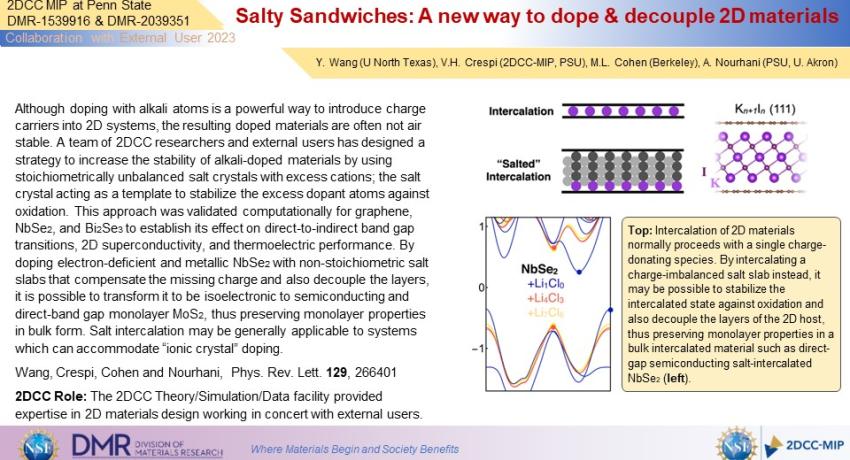Although doping with alkali atoms is a powerful way to introduce charge carriers into 2D systems, the resulting doped materials are often not air stable. A team of 2DCC researchers and external users has designed a strategy to increase the stability of alkali-doped materials by using stoichiometrically unbalanced salt crystals with excess cations; the salt crystal acting as a template to stabilize the excess dopant atoms against oxidation. This approach was validated computationally for graphene, NbSe2, and Bi2Se3 to establish its effect on direct-to-indirect band gap transitions, 2D superconductivity, and thermoelectric performance. By doping electron-deficient and metallic NbSe2 with non-stoichiometric salt slabs that compensate the missing charge and also decouple the layers, it is possible to transform it to be isoelectronic to semiconducting and direct-band gap monolayer MoS2, thus preserving monolayer properties in bulk form. Salt intercalation may be generally applicable to systems which can accommodate “ionic crystal” doping.
Wang, Crespi, Cohen and Nourhani, Phys. Rev. Lett. 129, 266401
2DCC Role: The 2DCC Theory/Simulation/Data facility provided expertise in 2D materials design working in concert with external users.
What Has Been Achieved: A means to dope layered materials that stabilizes the doped layers against oxidation (making them more useful for applications) and also decoupling the individual layers from each other by means of the insulating salt slabs intercalated between them, allowing one to recover monolayer-like behavior in bulk materials.
Importance of the Achievement: Many intriguing properties of 2D materials have limited application due to the thinness of the samples. If such properties (such as a direct bandgaps or 2D superconductivity) can be achieved in bulk materials by decoupling the layers, it may open the scope of possible applications for 2D and layered materials.
Unique Feature(s) of the MIP that Enabled this Achievement: Combination of in-house and external user expertise in computational materials design.
Publication: Nonstoichiometric Salt Intercalation as a Means to Stabilize Alkali Doping of 2D Materials, Yuanxi Wang, Vincent H. Crespi, Marvin L. Cohen, and Amir Nourhani
Phys. Rev. Lett. 129, 266401 https://doi.org/10.1103/PhysRevLett.129.266401
Acknowledgments: This work was supported by the National Science Foundation through the 2-Dimensional Crystal Consortium, a Materials Innovation Platform under DMR-1539916 and DMR-2039351, the Penn State Materials Research Science and Engineering Center under DMR-1420620 and DMR-2011839, and the Office of Science, Office of Basic Energy Sciences, Materials Sciences and Engineering Division of the Department of Energy under Contract No. DE-AC02-05-CH11231 within the Theory of Materials program (KC2301). M.L.C. support was also provided by NSF Grant No. DMR-1926004. Computational resources were in part from the 2DCC-MIP and the Department of Energy at Lawrence Berkeley National Laboratory, a NERSC facility. A.N. acknowledges startup funds from the University of Akron and Y.W. from the University of North Texas.
